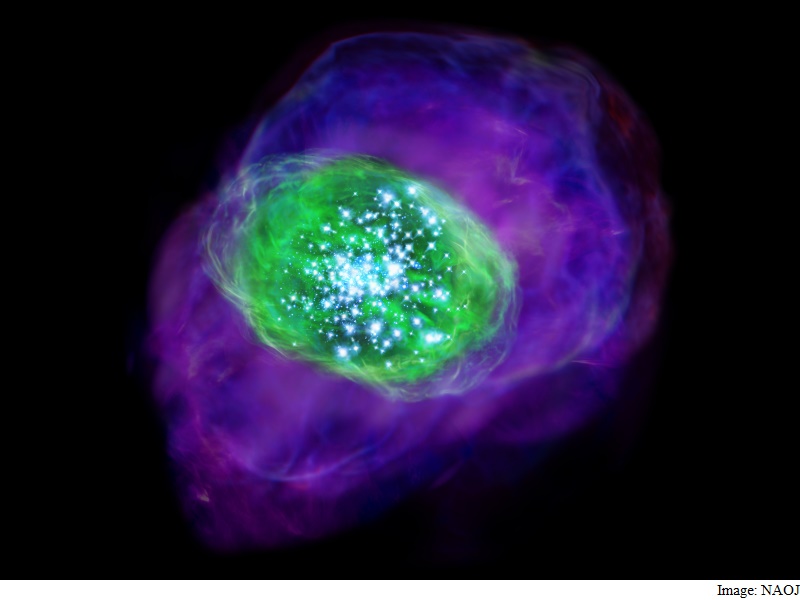Scientist have found the most distant galaxy with oxygen ever to be
detected, seen just 700 million years after the Big Bang, which provides
a glimpse into the early history of the universe.
Using the Atacama Large Millimetre/submillimetre Array (ALMA) in Chile, astronomers detected glowing oxygen in a distant galaxy.
The
galaxy SXDF-NB1006-2 lies at a redshift of 7.2, meaning that we see it
only 700 million years after the Big Bang, researchers said.
The
team was hoping to find out about the heavy chemical elements present in
the galaxy, as they can tell us about the level of star formation, and
hence provide clues about the period in the early universe known as
cosmic reionisation.
"Seeking heavy elements in the early universe
is an essential approach to explore the star formation activity in that
period," said Akio Inoue from the Osaka Sangyo University in Japan.
"Studying
heavy elements also gives us a hint to understand how the galaxies were
formed and what caused the cosmic reionisation," said Inoue.
In the time before objects formed in the universe, it was filled with electrically neutral gas.
However,
when the first objects began to shine, a few hundred million years
after the Big Bang, they emitted powerful radiation that started to
break up those neutral atoms - to ionise the gas.
During this phase - known as cosmic reionisation - the whole universe changed dramatically.
Researchers
carried out high-sensitivity observations with ALMA and found light
from ionised oxygen in SXDF-NB1006-2, making this the most distant
unambiguous detection of oxygen ever obtained.
It is firm evidence for the presence of oxygen in the early Universe, only 700 million years after the Big Bang.
Oxygen in SXDF-NB1006-2 was found to be ten times less abundant than it is in the Sun.
"The
small abundance is expected because the universe was still young and
had a short history of star formation at that time," said Naoki Yoshida
at the University of Tokyo.
The team was unable to detect any
emission from carbon in the galaxy, suggesting that this young galaxy
contains very little un-ionised hydrogen gas, and also found that it
contains only a small amount of dust, which is made up of heavy
elements.
The detection of ionised oxygen indicates that many very
brilliant stars, several dozen times more massive than the Sun, have
formed in the galaxy and are emitting the intense ultraviolet light
needed to ionise the oxygen atoms.
The findings were published in the journal Science.
 James Webb Space Telescope Captures Hourglass Nebula LBN 483 in Stunning Detail18 March 2025
James Webb Space Telescope Captures Hourglass Nebula LBN 483 in Stunning Detail18 March 2025 Mysterious Icy Objects Found in Milky Way Baffle Astronomers: Everything You Need to Know31 January 2025
Mysterious Icy Objects Found in Milky Way Baffle Astronomers: Everything You Need to Know31 January 2025 Trillions of Comets Found in 74 Alien Star Systems, Unveiling Exocomets and Planetary Belts27 January 2025
Trillions of Comets Found in 74 Alien Star Systems, Unveiling Exocomets and Planetary Belts27 January 2025 NASA Finds Black Hole Rotating at Unexpected Angle in NGC 5084 Galaxy20 December 2024
NASA Finds Black Hole Rotating at Unexpected Angle in NGC 5084 Galaxy20 December 2024 Ancient Galaxy Collisions May Explain Formation of Massive Early Star Systems9 December 2024
Ancient Galaxy Collisions May Explain Formation of Massive Early Star Systems9 December 2024

![[Sponsored] 10 Reasons to Buy Samsung Galaxy Book5 Series Laptops](https://c.ndtvimg.com/2025-03/6gg1i738_samsung-laptops_160x120_28_March_25.jpg?downsize=180:*)


![Gadgets 360 With Technical Guruji: Ask TG [ March 22, 2025]](https://c.ndtvimg.com/2024-12/5s52e4k_-ask-tg_640x480_14_December_24.jpg?downsize=180:*)










